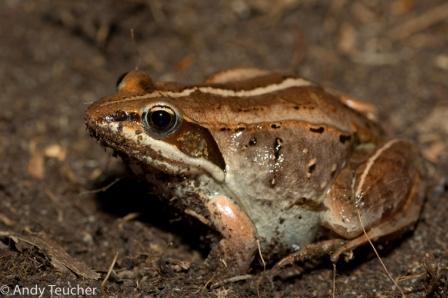
BC Conservation Data Centre: Conservation Status Report
Lithobates sylvaticus
Wood Frog

| Scientific Name: | Lithobates sylvaticus |
|---|---|
| Scientific Name Synonyms: |
Rana sylvatica
|
| English Name: | Wood Frog |
| Provincial Status Summary | |
| Status: | S5 |
| Date Status Assigned: | September 25, 2023 |
| Date Last Reviewed: | September 25, 2023 |
| Reasons: | Widespread and abundant; not of conservation concern in the vast majority of the range, though local populations can decline as a result of agricultural and residential development and intensive timber harvesting practices. |
| Range | |
| Range Extent: | G = 200,000-2,500,000 square km |
| Range Extent Comments: | Found in the northern ~80% of the province; east of the Coast Mountains, through the Cariboo region to Clinton and east through the Rocky Mountain Trench to Kootenay and Yoho National Park. It is found in the north from the Hayne's Triangle to the Petitot River in the north east corner of the province (Matsuda et al. 2006, iNaturalist [Accessed 22-February-2022]). |
| Area of Occupancy (km2): | U = Unknown |
| Occurrences & Population | |
| Number of Occurrences: | DE = 81 to >300 |
| Comments: | Many occurrences throughout the range. |
| Number of Occurrences with Good Viability / Ecological Integrity: | U = Unknown |
| Number of Occurrences Appropriately Protected & Managed: | Rank Factor not assessed |
| Population Size: | U = Unknown |
| Comments: | Data is needed to determine population numbers in BC |
| Threats (to population, occurrences, or area affected) | |
| Degree of Threat: | D = Low |
| Comments: | An expert threats assessment was conducted in 2023. The largest threats are the impact of roads, habitat shifts and periodic drought due to climate change at the south end of the species range in BC. Low level of threat for this widespread species. |
| Trend (in population, range, area occupied, and/or condition of occurrences) | |
| Short-Term Trend: | U = Unknown |
| Comments: | Population trend is unknown but probably stable to slightly declining. |
| Long-Term Trend: | U = Unknown |
| Other Factors | |
| Intrinsic Vulnerability: | C=Not intrinsically vulnerable |
| Comments: | Females lay from 40 to more than 1500 eggs in a mass.Tadpoles grow quickly, even at low temperatures. Wood frogs are able to tolerate low temperatures and can survive many days in a frozen state (Matsuda et. al. 2006). |
| Environmental Specificity: | CD = Moderate to broad. |
| Comments: | Wood frogs can be found in forests, fields and muskegs. They are terrestrial during the summer and fall (Matsuda et al. 2006). |
| Other Rank Considerations: | |
| Information Gaps | |
| Research Needs: | |
| Inventory Needs: | |
| Stewardship | |
| Protection: | |
| Management: | |
| Version | |
| Author: | Gelling, L. and L. Ramsay |
| Date: | February 22, 2022 |
| References | |
|
Canadian Herpetological Society. 2022. Species Information, Wood Frog, Lithobates sylvaticus, Accessed February 2022. https://canadianherpetology.ca/species/species_page.html?cname=Wood%20Frog
|
|
|
Govindarajulu et al. 2013. Batrachochytrium dendrobatidis surveillance in British Columbia 2008-2009, Canada. 5pp.
|
|
Please visit the website Conservation Status Ranks for information on how the CDC determines conservation status ranks. For global conservation status reports and ranks, please visit the NatureServe website http://www.natureserve.org/.
Suggested Citation:
B.C. Conservation Data Centre. 2022. Conservation Status Report: Lithobates sylvaticus. B.C. Minist. of Environment. Available: https://a100.gov.bc.ca/pub/eswp/ (accessed May 9, 2025).